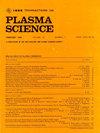纳秒放电对乙烯-空气混合物点火延迟的动力学影响
IF 1.5
4区 物理与天体物理
Q3 PHYSICS, FLUIDS & PLASMAS
引用次数: 0
摘要
本文建立了一个零维动力学模型,研究了纳秒脉冲放电对化学计量乙烯-空气混合物点火特性的影响。模拟框架结合了等离子体动力学的ZDPlasKin和燃烧化学的CHEMKIN。结果表明,在初始温度为1200 K、压力为1.1 atm、等离子体能量输入为20 mJ/cm3的条件下,纳秒放电比自燃明显缩短了点火延迟时间。点火增强在很大程度上取决于电场E/N的减小,在200 Td时达到最小延迟。促进着火的主要自由基o、H、C2H和c2h3主要是通过电子激发的氮种猝灭反应产生的,尤其是N2(A)和N2($\text{A}^{\prime}$)。通径通量分析表明,电子碰撞对O的形成有重要作用,而H和C2H3主要是通过N2淬火形成的。自由基产量随E/N的变化解释了点火延迟时间的非单调趋势。本文章由计算机程序翻译,如有差异,请以英文原文为准。
Kinetic Effects of Nanosecond Discharge on the Ignition Delay of Ethylene–Air Mixtures
This study develops a zero-dimensional kinetic model to investigate the effects of nanosecond pulsed discharge on the ignition characteristics of stoichiometric ethylene–air mixtures. The simulation framework combines ZDPlasKin for plasma kinetics and CHEMKIN for combustion chemistry. At an initial temperature of 1200 K, a pressure of 1.1 atm, and a fixed plasma energy input of 20 mJ/cm3, the results show that the nanosecond discharge significantly shortens the ignition delay time compared to autoignition. The ignition enhancement strongly depends on the reduced electric field $E/N$ , reaching a minimum delay at 200 Td. The primary radicals responsible for promoting ignition—O, H, C2H, and C2H3—are mainly produced through quenching reactions of electronically excited nitrogen species, particularly N2(A) and N2( $\text{a}^{\prime }$ ). Path flux analysis reveals that electron collisions contribute significantly to O formation, while H and C2H3 are predominantly formed via N2 quenching. The variation in radical production with $E/N$ explains the non monotonic trend of ignition delay time.
求助全文
通过发布文献求助,成功后即可免费获取论文全文。
去求助
来源期刊

IEEE Transactions on Plasma Science
物理-物理:流体与等离子体
CiteScore
3.00
自引率
20.00%
发文量
538
审稿时长
3.8 months
期刊介绍:
The scope covers all aspects of the theory and application of plasma science. It includes the following areas: magnetohydrodynamics; thermionics and plasma diodes; basic plasma phenomena; gaseous electronics; microwave/plasma interaction; electron, ion, and plasma sources; space plasmas; intense electron and ion beams; laser-plasma interactions; plasma diagnostics; plasma chemistry and processing; solid-state plasmas; plasma heating; plasma for controlled fusion research; high energy density plasmas; industrial/commercial applications of plasma physics; plasma waves and instabilities; and high power microwave and submillimeter wave generation.
 求助内容:
求助内容: 应助结果提醒方式:
应助结果提醒方式:


